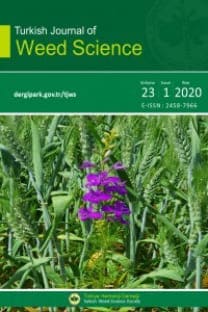Trabzon Orman Fidanlığındaki Yabancı Ot Türlerinin Bazı Botanik Özellikleri
Trabzon-Of Orman Fidanlığında bulunan yabancı otların (diri örtü elemanları) belirlenmesi amacıyla yapılan bu çalışma, 2013-2014 yılları arasında gerçekleştirilmiştir. Araştırma alanında eğreltiler (Pteridophyta) ve tohumlu bitkiler (Spermatophyta) bölümleri dâhil toplamda 53 familya, 121 cinse ait 151 takson belirlenmiştir. Pteridophyta bölümüne ait 4 adet ve Spermatophyta bölümünün kapalı tohumlular (Angiospermae) alt bölümünde bulunan 147 adet takson saptanmıştır. Literatüre göre araştırma alanında 39 (%25,8) taksonun fitocoğrafik bölgesi belirlenmiş olup, bu taksonların tümü Avrupa-Sibirya elementidir. Ayrıca, 16 (%10,6) adet kozmopolit, 18 (%11,9) adet egzotik ve 1 (%0,7) adet nadir takson tespit edilmiştir. Araştırma alanındaki taksonların yoğun çiçeklenme zamanı Haziran, Temmuz ve Ağustos olduğu tespit edilmiştir. Araştırma alanında saptanan taksonlardan 86 (%57) adet takson çok yıllık (perennial), 47 (% 31) adet takson bir yıllık (annual), 8 (% 5) adet takson iki yıllık (biannual) ve 10 (% 7) adet takson odunsu olarak belirlenmiştir. En çok takson içeren familyalar; Compositae 24 (%15,9), Fabaceae 14 (%9,3), Poaceae 11 (%7,3), Polygonaceae 8 (%5,3) ve Lamiaceae 7 (%4,6)' dır. Ayrıca, Raunkiaer bitki hayat formuna göre 80 (%53) adet Hemicryptophyte, 47 (%31) adet Therophyte, 14 (%9) adet Geophyte ve 10 (%7) adet Phanerophyte yabancı ot türü belirlenmiştir
Anahtar Kelimeler:
Botanik özellikleri, yabancı ot, orman fidanlığı, Trabzon
Some Botanical Features of Weed Species Prevailing in Forest Nursery of Trabzon Province
This study was conducted in order to determine the prevalence of different weed taxa in forest nursery (Of-Nursery) of Trabzon province, during 2013 and 2014. A total of 53 families and 151 taxa and 121 species belonging to Pteridophyta and Spermatophyta divisions were identified. Among the identified taxa, 4 belonged to Pteridophyta while remaining 147 belonged to Spermatophyta. According to literature, phytogeographical analysis of the observed taxa revealed that 39 (25.8%) taxa belonged to Euro-Siberian region. Similarly, 16 (10.6%) taxa were cosmopolitan, 18 (11.9%) exotic and 1 (0.7%) taxa was identified as rare. The months of June, July and August were identified as the intensive flowering period of the identified taxa during the study. According to the season, 86 (57%) taxa consisted of perennial species, 47 (31%) annual, 8 (5%) biannual and 10 (7%) were woody in nature. The plant families having the highest number of taxa were; Compositae 24 (15.9%), Fabaceae 14 (9.3%), Poaceae 11 (7.3%), Polygonaceae 8 (5.3%) and Lamiaceae 7 (4.6%). Moreover, according to Raunkiaer plant life-form 80 (53%) taxa were Hemicryptophyte, 47 (31%) Therophyte, 14 (9%) Geophyte and 10 (7%) were Phanerophyte
Keywords:
Botanical features, weed, forest nursery, Trabzon,
___
- Altland J. (2005). Weed Control in Nursery Field Production. Extension Horticulture Faculty, North Willamette Research and Extension Center, Oregon State University. EM 8899-E, November.
- Anonim. (2007-2011). Of Orman Fidanlığı Rotasyon Planı. Davis P.H (ed.). (1965-1985). Flora of Turkey and the East Aegean Islands, I-IX., Edinburgh University Press, Edinburgh. Dill T. R., Carter M. C. (2015). Reemergence Weed Control in Southeastern Forest Nurseries Weed Science, Vol. 21, No. 4, pp. 363-366.
- Erdem M., Topak R., Coşgun U., Terzi M. (2002). Bolu Orman Fidanlığı’nda Tarımda Kullanılan Herbisitlerin Kullanılmasının Ot Mücadelesine, Fidan Yaşama Kabiliyetine ve Fidanlık Ekonomisine Katkılarının İncelenmesi. Batı Karadeniz Ormancılık Araştırma Müdürlüğü, Bakanlık Yayın No: 149, Müdürlük Yayın No: 14, Teknik Bülten No: 8, Bolu.
- Gökdemir Ş. (1998). Orman Fidanlıklarında (Ordu, Hendek ve Devrek) Belirlenen Yabancı Otlar ve Kimyasal Savaşımları Üzerine Araştırmalar, Doktora Tezi, KTÜ Fen Bilimleri Enstitüsü, Trabzon. Hanf M. (1983). The Arable Weeds of Europe with Their Seedlings and Seeds. Basf Aktiengesellschaft, s 494, D-6700 Ludwigshafen.
- Kinch, R. (1936). Nebrasca Weeds State of Nebrasca Department of Agriculture and Inspection, s 238, Lincoln.
- Munjuga M. (2006). Method for nursery production: theory, lecture hand out for Allanblackia tree domestication course, 23 th to 27 th October 2006.
- Önen H., (Ed.). (2015). Türkiye İstilacı Bitkiler Kataloğu. Ankara: T.C. Gıda Tarım ve Hayvancılık Bakanlığı. ISBN: 978- 605-9175-05-0.
- Özer Z., Kadıoğlu İ., Önen H., Tursun N. 2001. Herboloji (Yabancı Ot Bilimi) Gaziosmanpaşa Üniversitesi Ziraat Fakültesi Yayınları No: 20, Kitap Serisi No: 10, 3. Baskı, Tokat (In Turkish).
- Pandya Prashant R. (2009). “A Study of the Weed Flora of Some Cultivated Fields of Bharuch District”, thesis PhD, Saurashtra University.
- Raunkiaer C. (1934).The Life Forms of Plants and Statistical Plant Geography, Calderon Press, Oxford, 147 s. Shaw W. (1956). Terminology Committee Report, Weed Society of America. Weeds, 4: p.278.
- Thornton B.J., Harrington H.D. (1960).Weeds of Colorado, Agricultural Experiment Station Colorado State University, Fort Collins, Bulletin 514, 218.
- Yahyaoğlu Z. (1993). Tohum Teknolojisi ve Fidanlık Tekniği, Karadeniz Teknik Üniversitesi Orman Fakültesi Yayınları, Yayın No: 43, Trabzon.
- ISSN: 1303-6491
- Başlangıç: 1998
- Yayıncı: Türkiye Herboloji Derneği
Sayıdaki Diğer Makaleler
Trabzon Orman Fidanlığındaki Yabancı Ot Türlerinin Bazı Botanik Özellikleri
Nebahat YILDIRIM, İbrahim TURNA
Yusuf YANAR, Sabriye BELGÜZAR, İsa TELCİ
Yusuf YANAR, Sabriye BELGÜZAR, İsa TELCİ
Bülent BAŞARAN, İzzet KADIOĞLU
Bülent BAŞARAN, İzzet KADIOĞLU
Karpuz Mozaik Virüsü (WMV - 2)’nün Doğal Konukçusu Sicyos
Fatime KORKMAZ, Kübra KARACA, Cumali ÖZASLAN, Yusuf YANAR, Hüseyin ÖNEN
